
Cirkit Designer
Your all-in-one circuit design IDE
Home /
Component Documentation
How to Use ESP32: Examples, Pinouts, and Specs
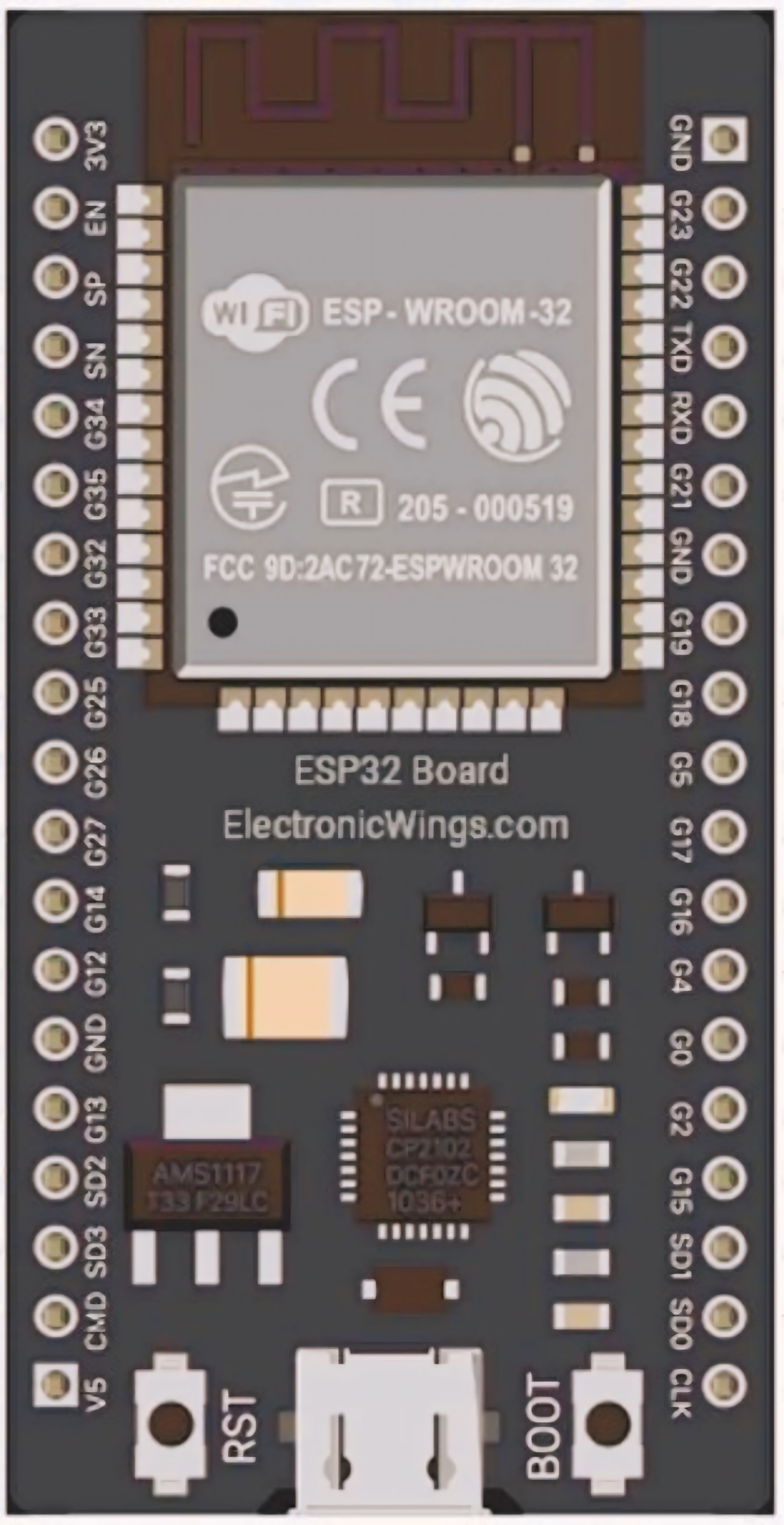
 Design with ESP32 in Cirkit Designer
Design with ESP32 in Cirkit DesignerIntroduction
The ESP32 is a low-cost, low-power system on a chip (SoC) with integrated Wi-Fi and dual-mode Bluetooth. It is widely used for Internet of Things (IoT) applications due to its versatility and robust feature set. The ESP32 is designed to be scalable and adaptive, providing a range of power and performance options. It is ideal for applications such as smart home devices, wearables, industrial automation, and more.
Explore Projects Built with ESP32
ESP32-Based Sensor Monitoring System with OLED Display and E-Stop
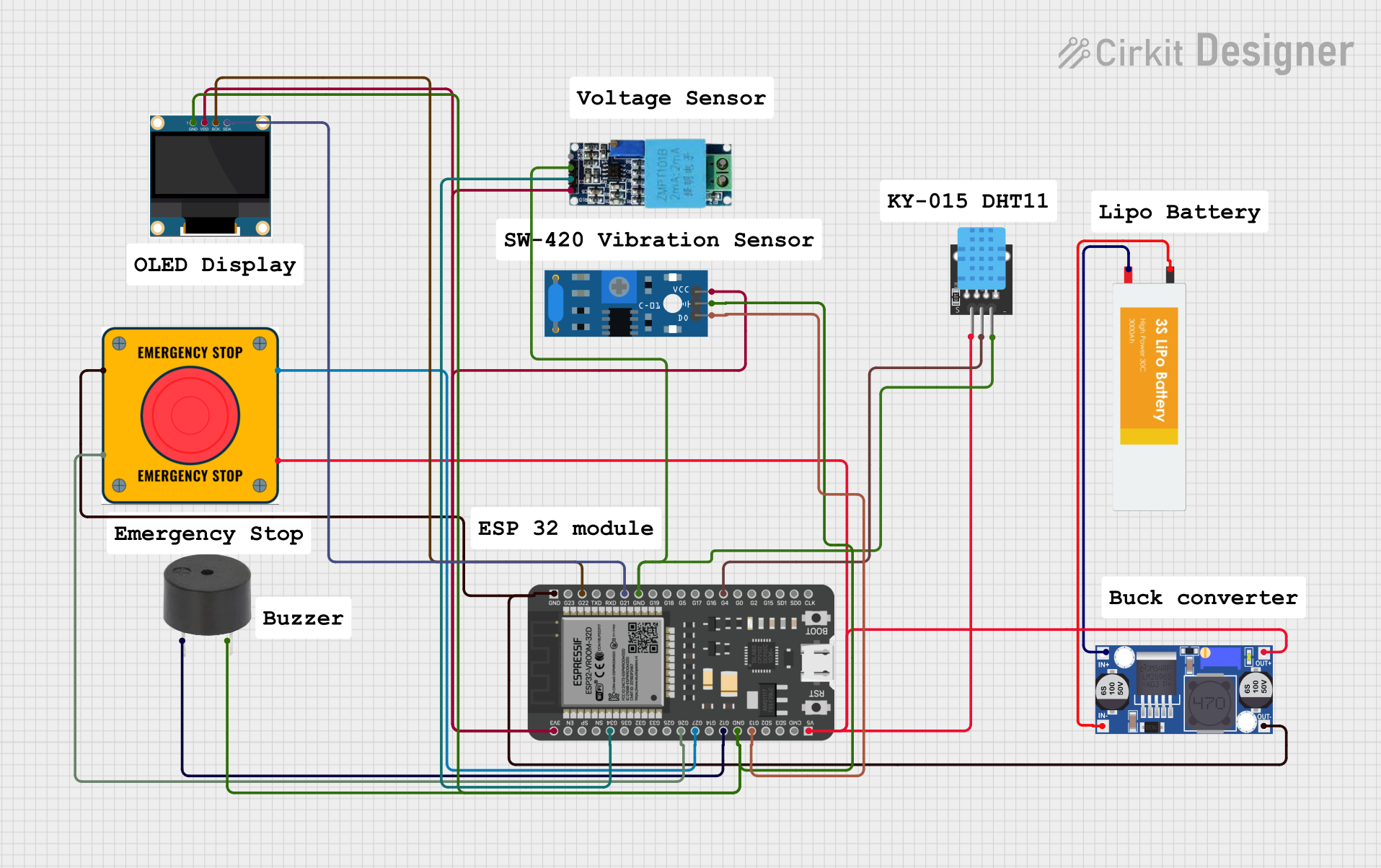
This circuit features an ESP32 microcontroller that interfaces with a variety of sensors and output devices. It is powered by a Lipo battery through a buck converter, ensuring a stable voltage supply. The ESP32 collects data from a DHT11 temperature and humidity sensor and a vibration sensor, controls a buzzer, and displays information on an OLED screen. An emergency stop (E Stop) is connected for safety purposes, allowing the system to be quickly deactivated.
 Open Project in Cirkit Designer
Open Project in Cirkit DesignerESP32-Based NTP Clock with DHT22 Temperature Sensor and WS2812 LED Matrix Display
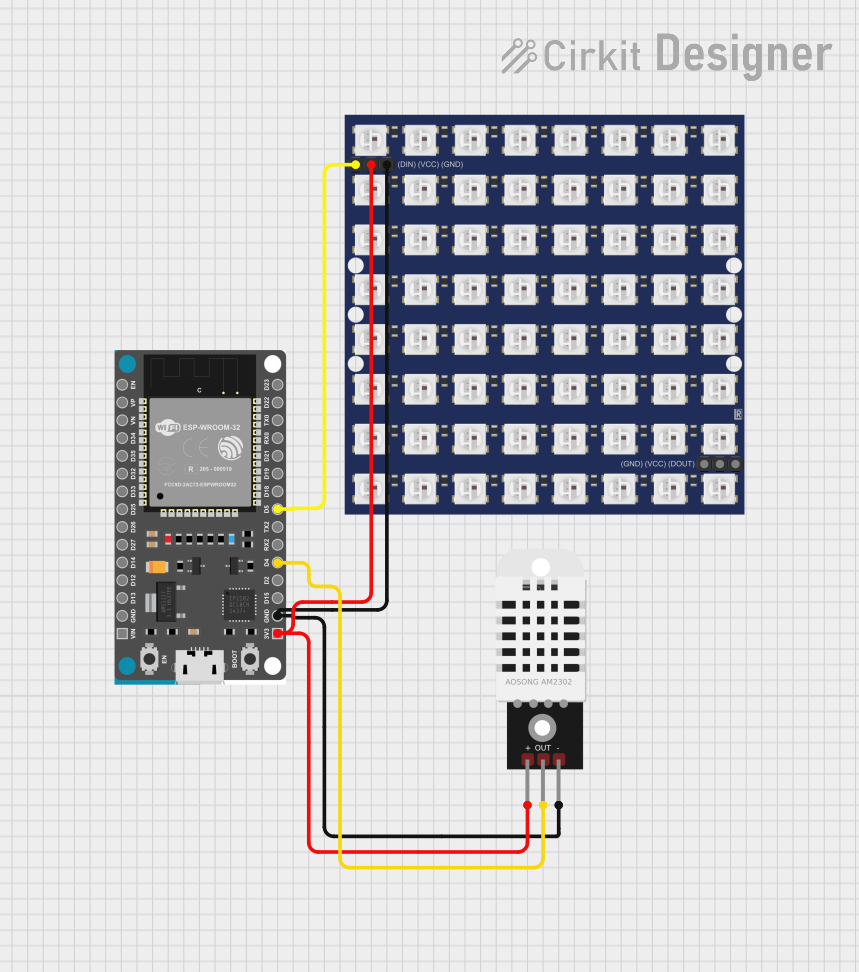
This circuit features an ESP32 Devkit V1 microcontroller connected to a DHT22 temperature and humidity sensor and an 8x8 WS2812 RGB LED matrix. The ESP32 reads temperature data from the DHT22 sensor and displays the current date, time, and temperature on the LED matrix, with date and time synchronized via NTP (Network Time Protocol). The ESP32 provides power to both the DHT22 and the LED matrix and communicates with the DHT22 via GPIO 4 and with the LED matrix via GPIO 5.
 Open Project in Cirkit Designer
Open Project in Cirkit DesignerESP32-Based Environmental Monitoring System with Water Flow Sensing
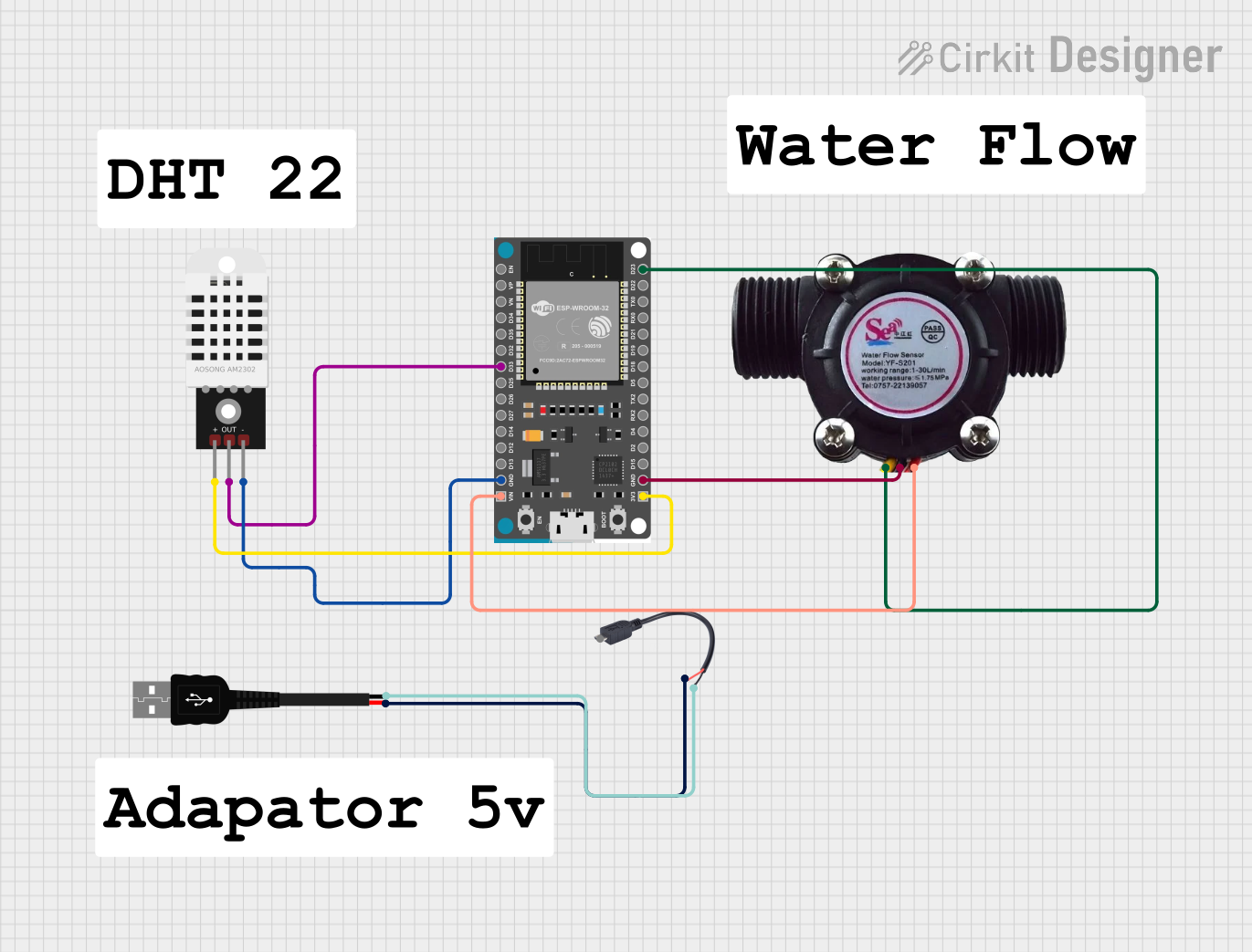
This circuit features an ESP32 Devkit V1 microcontroller connected to a DHT22 temperature and humidity sensor and a water flow sensor. The ESP32 reads environmental data from the DHT22 via a digital input pin (D33) and monitors water flow through the water flow sensor connected to another digital input pin (D23). The ESP32 is powered through its VIN pin, and both sensors are powered by the ESP32's 3V3 output, with common ground connections.
 Open Project in Cirkit Designer
Open Project in Cirkit DesignerESP32-Based Smart Weather Station with Wi-Fi Connectivity
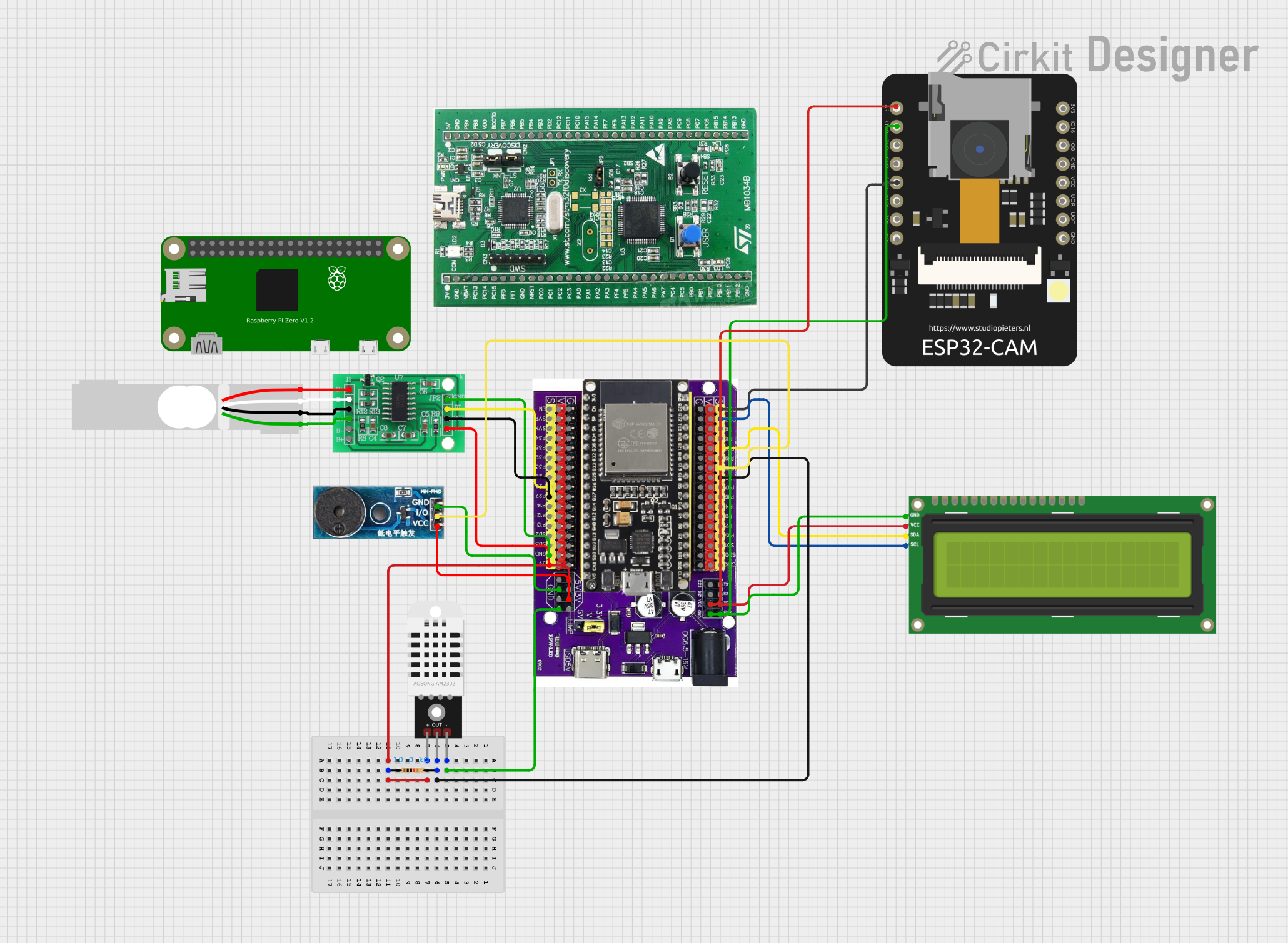
This circuit features an ESP32 microcontroller interfacing with various sensors and modules, including a DHT22 temperature and humidity sensor, an ESP32 CAM for image capture, an I2C LCD screen for display, a load cell with an HX711 interface for weight measurement, and a buzzer for audio alerts. The ESP32 handles data acquisition, processing, and communication with these peripherals to create a multi-functional monitoring and alert system.
 Open Project in Cirkit Designer
Open Project in Cirkit DesignerExplore Projects Built with ESP32

ESP32-Based Sensor Monitoring System with OLED Display and E-Stop
This circuit features an ESP32 microcontroller that interfaces with a variety of sensors and output devices. It is powered by a Lipo battery through a buck converter, ensuring a stable voltage supply. The ESP32 collects data from a DHT11 temperature and humidity sensor and a vibration sensor, controls a buzzer, and displays information on an OLED screen. An emergency stop (E Stop) is connected for safety purposes, allowing the system to be quickly deactivated.
 Open Project in Cirkit Designer
Open Project in Cirkit Designer
ESP32-Based NTP Clock with DHT22 Temperature Sensor and WS2812 LED Matrix Display
This circuit features an ESP32 Devkit V1 microcontroller connected to a DHT22 temperature and humidity sensor and an 8x8 WS2812 RGB LED matrix. The ESP32 reads temperature data from the DHT22 sensor and displays the current date, time, and temperature on the LED matrix, with date and time synchronized via NTP (Network Time Protocol). The ESP32 provides power to both the DHT22 and the LED matrix and communicates with the DHT22 via GPIO 4 and with the LED matrix via GPIO 5.
 Open Project in Cirkit Designer
Open Project in Cirkit Designer
ESP32-Based Environmental Monitoring System with Water Flow Sensing
This circuit features an ESP32 Devkit V1 microcontroller connected to a DHT22 temperature and humidity sensor and a water flow sensor. The ESP32 reads environmental data from the DHT22 via a digital input pin (D33) and monitors water flow through the water flow sensor connected to another digital input pin (D23). The ESP32 is powered through its VIN pin, and both sensors are powered by the ESP32's 3V3 output, with common ground connections.
 Open Project in Cirkit Designer
Open Project in Cirkit Designer
ESP32-Based Smart Weather Station with Wi-Fi Connectivity
This circuit features an ESP32 microcontroller interfacing with various sensors and modules, including a DHT22 temperature and humidity sensor, an ESP32 CAM for image capture, an I2C LCD screen for display, a load cell with an HX711 interface for weight measurement, and a buzzer for audio alerts. The ESP32 handles data acquisition, processing, and communication with these peripherals to create a multi-functional monitoring and alert system.
 Open Project in Cirkit Designer
Open Project in Cirkit DesignerTechnical Specifications
Key Technical Details
| Parameter | Value |
|---|---|
| CPU | Xtensa® Dual-Core 32-bit LX6 |
| Clock Speed | Up to 240 MHz |
| Flash Memory | 4 MB (varies by model) |
| SRAM | 520 KB |
| Wi-Fi | 802.11 b/g/n |
| Bluetooth | v4.2 BR/EDR and BLE |
| Operating Voltage | 2.2V to 3.6V |
| GPIO Pins | 34 |
| ADC Channels | 18 (12-bit) |
| DAC Channels | 2 (8-bit) |
| Communication | UART, SPI, I2C, I2S, CAN, Ethernet, PWM |
| Power Consumption | Ultra-low power (varies by mode) |
Pin Configuration and Descriptions
| Pin Number | Pin Name | Description |
|---|---|---|
| 1 | EN | Enable (Active High) |
| 2 | GPIO0 | General Purpose I/O |
| 3 | GPIO1 | General Purpose I/O |
| 4 | GPIO2 | General Purpose I/O |
| 5 | GPIO3 | General Purpose I/O |
| 6 | GPIO4 | General Purpose I/O |
| 7 | GPIO5 | General Purpose I/O |
| 8 | GPIO6 | General Purpose I/O |
| 9 | GPIO7 | General Purpose I/O |
| 10 | GPIO8 | General Purpose I/O |
| 11 | GPIO9 | General Purpose I/O |
| 12 | GPIO10 | General Purpose I/O |
| 13 | GPIO11 | General Purpose I/O |
| 14 | GPIO12 | General Purpose I/O |
| 15 | GPIO13 | General Purpose I/O |
| 16 | GPIO14 | General Purpose I/O |
| 17 | GPIO15 | General Purpose I/O |
| 18 | GPIO16 | General Purpose I/O |
| 19 | GPIO17 | General Purpose I/O |
| 20 | GPIO18 | General Purpose I/O |
| 21 | GPIO19 | General Purpose I/O |
| 22 | GPIO20 | General Purpose I/O |
| 23 | GPIO21 | General Purpose I/O |
| 24 | GPIO22 | General Purpose I/O |
| 25 | GPIO23 | General Purpose I/O |
| 26 | GPIO24 | General Purpose I/O |
| 27 | GPIO25 | General Purpose I/O |
| 28 | GPIO26 | General Purpose I/O |
| 29 | GPIO27 | General Purpose I/O |
| 30 | GPIO28 | General Purpose I/O |
| 31 | GPIO29 | General Purpose I/O |
| 32 | GPIO30 | General Purpose I/O |
| 33 | GPIO31 | General Purpose I/O |
| 34 | GPIO32 | General Purpose I/O |
| 35 | GPIO33 | General Purpose I/O |
| 36 | GPIO34 | General Purpose I/O |
| 37 | GPIO35 | General Purpose I/O |
| 38 | GPIO36 | General Purpose I/O |
| 39 | GPIO37 | General Purpose I/O |
| 40 | GPIO38 | General Purpose I/O |
| 41 | GPIO39 | General Purpose I/O |
Usage Instructions
How to Use the ESP32 in a Circuit
- Power Supply: Connect the ESP32 to a stable power supply within the range of 2.2V to 3.6V. Typically, 3.3V is used.
- GPIO Pins: Use the GPIO pins for interfacing with sensors, actuators, and other peripherals. Each GPIO pin can be configured as input or output.
- Programming: The ESP32 can be programmed using the Arduino IDE, Espressif's ESP-IDF, or other compatible environments.
- Wi-Fi and Bluetooth: Utilize the integrated Wi-Fi and Bluetooth for wireless communication. Libraries are available to simplify the process.
Important Considerations and Best Practices
- Power Management: Use appropriate power management techniques to optimize battery life in low-power applications.
- Pin Multiplexing: Be aware of pin multiplexing and avoid conflicts by consulting the ESP32 datasheet.
- Antenna Placement: Ensure proper antenna placement for optimal wireless performance.
- Firmware Updates: Keep the firmware updated to benefit from the latest features and security patches.
Example Code for Arduino UNO
#include <WiFi.h>
// Replace with your network credentials
const char* ssid = "your_SSID";
const char* password = "your_PASSWORD";
void setup() {
Serial.begin(115200);
// Connect to Wi-Fi
WiFi.begin(ssid, password);
// Wait for connection
while (WiFi.status() != WL_CONNECTED) {
delay(1000);
Serial.println("Connecting to WiFi...");
}
Serial.println("Connected to WiFi");
}
void loop() {
// Put your main code here, to run repeatedly
}
Troubleshooting and FAQs
Common Issues Users Might Face
- Wi-Fi Connection Issues: Ensure the correct SSID and password are used. Check for interference and signal strength.
- Power Supply Problems: Verify that the power supply is stable and within the specified voltage range.
- Programming Errors: Ensure the correct board and port are selected in the Arduino IDE or other programming environment.
Solutions and Tips for Troubleshooting
- Wi-Fi Connection: Move closer to the router or use a Wi-Fi extender to improve signal strength.
- Power Supply: Use a decoupling capacitor to stabilize the power supply.
- Programming: Double-check the connections and ensure the ESP32 is in boot mode if required.
By following this documentation, users can effectively utilize the ESP32 in their projects, leveraging its powerful features for a wide range of applications.